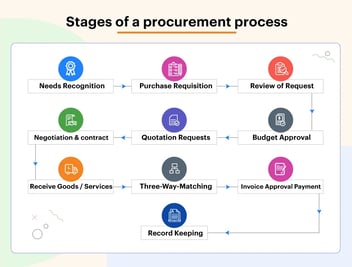
- >
- procurement >
- 11 Essential Procurement KPIs You Can’t Ignore
11 Essential Procurement KPIs You Can’t Ignore
Businesses today want procurement teams to drive value beyond cost savings. As a result, procurement leaders are constantly looking for ways to improve their procurement process and make it more sustainable. However, they don’t want to make any decisions without the right data. And so, they track an array of purchasing metrics as KPIs.
While procurement key performance indicators (KPIs) is a widely used buzzword in procurement circles, they are not set on stone. Procurement KPIs means different things to different businesses, almost to the point that most procurement leaders aren’t sure what counts as a KPI and what doesn’t.
But when it comes to decision-making and performance tracking, how can you be sure that the purchasing KPIs that are being tracked matter the most? Only by gaining a better understanding of the purchasing metrics and taking a look at the procurement KPIs that are used by industry leaders.
What are procurement KPIs?
Procurement KPIs are a type of performance measurement tool that are used to evaluate and monitor the efficiency of an organization’s procurement management. These KPIs help an organization optimize and regulate spending, quality, time, and cost.
Additionally, procurement KPIs help businesses keep pace with their overall process goals, procurement strategies, and business objectives.
Why measure the efficiency of your procurement process?
The saying “If you cannot measure it, you cannot improve it” holds as true as ever. Measuring the efficiency of a procurement process is important, as it plays a critical role in the supply chain in the case of an economic downturn. A great way to improve procurement efficiency is to automate. Here’s a free ebook to get you started on automation.
While cost savings are an obvious objective of procurement performance, it is not just restricted to that. By measuring the performance of a procurement process, organizations can find answers to other important questions like:
- What needs to be improved?
- How do we compare with other organizations?
11 KPIs every procurement team should measure without fail
The right procurement KPI is relevant to your business goals and simple to track. While you’re drafting your first procurement KPIs, it can be a bit overwhelming. By gaining a better understanding of their purpose, you would be able to identify KPIs that better serves your needs.
Listed below are eleven procurement KPIs that every organization should keep track of:
- Compliance rate
- Supplier defect rate
- PO and invoice accuracy
- Rate of emergency purchases
- Supplier lead time
- PO cycle time
- Vendor availability
- Cost per invoice and PO
- Spend under management (SUM)
- Procurement ROI and benefits
- Price Competitiveness
Depending on their purpose, these procurement KPIs can be split into three major categories: ensure quality, improve delivery, and deliver savings. All three categories are interdependent, so focusing on just one category might harm the other two and decrease the process sustainability.
1. Quality KPIs: Ensure quality
Compliance rate
Contractual and policy compliance are pivotal to ensure legal security. If these compliance rates dip down, they can spike up indirect and maverick spend. A foolproof purchasing contract with clearly defined penalties can improve the compliance rate
Metrics to note:
- The ratio of disputed invoices to total invoices
- The total difference between the price paid and the price quoted
Supplier defect rate
Supplier defect rate is used to evaluate a supplier’s individual quality. Measuring supplier defect rates and breaking it down based on the defect type will offer actionable insights into a supplier’s trustworthiness. Supplier defect rates are usually measured in defects per million.
Supplier defect rate= Number of substandard products/Total number of units tested
PO accuracy
Low PO accuracy hikes up operating costs. Procurement KPIs are measured across supply categories, buyer segments, and more. This metric will help businesses ensure whether suppliers are delivering what was ordered and if it was delivered at the right time.
Indicators to track:
- The ratio of product/service delivered outside the pre-defined service target
- % of erroneous delivery over the total number of purchase orders in a period of time
2. Delivery KPIs: Improve delivery
Rate of emergency purchases
Emergency purchases are those unplanned orders which are acquired to prevent the shortage of products/services. This metric is measured with the ratio of emergency purchases to the total number of purchases over a fixed period of time.
By lowering the rate of emergency orders, organizations can:
- Save costs
- Improve procurement plan
- Reduce supply risks
- Ensure continuity
Supplier lead time
Supplier lead time is the amount of time that elapses between the time a supplier receives an order and the time when the order is shipped. This KPI is often measured in days. Vendor lead time starts with availability confirmation and ordering and ends with the delivery of goods.
Supplier lead time = Delivery time (Goods and receipts delivery) – Order time (PO acceptance)
Purchase order cycle time
Purchase order cycle time is measured in hours or days from the time a purchase requisition is submitted to the time when it is transmitted to a vendor or contractor. This KPI covers the end-to-end ordering process which makes up the whole purchase order cycle.
Vendor availability
Vendor availability is used to measure a vendor’s capacity to respond to emergency demands. This procurement KPI helps organizations determine the degree of reliability they can place on a vendor.
Vendor availability (%) is measured by the ratio of the number of time items available on a vendor’s side to the number of orders placed with the supplier.
3. Cost-Saving KPIs: Receive savings
Cost per invoice and purchase order side
The cost spent per invoice and purchase order can vary from one organization to another depending on the factors that are included in this calculation. An organization that follows a manual approach will have higher processing costs when compared to other organizations that use an automated process.
A recent APQC survey shows that organizations with little to no automation in place end up spending at least $10 or more per invoice.
Spend under management
Spend under management is the percentage of procurement spend that is regulated or controlled by the management. As an organization’s spend under management rises up, its ability to optimize cost and forecast expense increases with it.
SUM = Total approved spend (i.e., direct, indirect, and service-related cost ) – Maverick spend
Procurement ROI
Procurement ROI is used to determine the profitability and cost-effectiveness of the procurement investment. This metric is best suited for internal analysis.
Procurement ROI = Annual cost savings / Annual procurement cost
Build faster, spend less. Kissflow quantifies the real impact of low-code adoption.
Price competitiveness
Little to no competition among vendors can lead to a place where a few suppliers enjoy a monopoly. This can lower quality over the long run. Here the emphasis is placed on shortlisting vendors that offer the buyer a distinct competitive advantage.
Price competitiveness can be measured by comparing the price paid with the published market prices listed on procurement market intelligent sites like Beroe Inc.
It also gives procurement leaders the ability to create custom reports that show key metrics like PO cycle time, the rate of emergency purchases, and the annual procurement savings to annual procurement costs.
Using an eProcurement tool is the key to improve procurement performance
To step up procurement performance, organizations need to take KPI measurements and tracking digital. Using a cloud-based tool will help organizations with data collection, segregation, routing, retrieval, and much more. This lets procurement staff spend more time analyzing the collected data.
Still unsure about the importance of an eProcurement tool? Download this free ebook to learn more!
Using an E-procurement software offers a number of great benefits like:
-
- Drastic reduction in process time
- A steep rise in productivity
- Increase in speed and efficiency
- Radical gains in terms of compliance
- Substantial cost savings
- Significant reduction of risk
- Enhanced visibility of the whole process
Visualizing and tracking procurement KPIs using Kissflow Procurement Cloud
With Kissflow, organizations get access to one comprehensive tool that handles procurement processes throughout the procure-to-pay cycle. As this is a cloud-based solution, it has all procurement data available for instant access. This means you can measure procurement KPIs effortlessly.
Kissflow Procurement Cloud offers dedicated tools to take care of procurement functions like purchase order and purchase request management, invoice and contract management, and vendor management as well. All of the data from these processes are connected and available with context, and the 360-degree visibility Kissflow offers to ensure consistency and transparency across the whole process cycle, throughout core processes like vendor evaluation and performance ratings.
Tracking procurement KPIs has never been easier, with Kissflow’s function-specific tools that collect, store, and analyze necessary information with minimal human effort. Collected data is then shared with all relevant parties with role-based access to ensure data security.
Moreover, Kissflow Procurement Cloud can provide automated reminders to procurement leaders and vendors alike to keep processes on track.
It also gives procurement leaders the ability to create custom reports that show key metrics like PO cycle time, the rate of emergency purchases, and the annual procurement savings to annual procurement costs.
Optimize your procurement processes with low-code—reduce manual work, enhance transparency, and improve efficiency in sourcing and purchasing.
Recommended Reading:
- Top 6 Challenges in Procurement and How to Overcome Those
- The Procurement System Buyer’s Guide 2024
- 8 Reasons to Automate your Procurement Process Today
- How Manual Processes Are Killing Your Procurement Efforts
Summary
The process of developing procurement KPIs at an organization isn’t always a clear-cut task. But, when procurement leaders take the time to identify their business needs and understand the nature of procurement key performance indicators, it is easy to pick those which are in tune with an organization’s goals.
A cloud-based digital procurement solution can help businesses measure KPIs, gain actionable insights, mitigate risks, and increase profitability.
Looking for ways to improve the efficiency of your procurement process? Sign up for a free demo of Kissflow Procurement Cloud today, and see how effortless it is to track all the procurement metrics that matter.
Learn how Kissflow platform can optimize your procurement processes. Whether you're an IT Leader, Developer, Process Owner, or Business Manager, low-code is transforming the way enterprises build applications. Unlock agility and innovation with Kissflow.
Streamline Your Procurement Process With Kissflow
Your search for Procurement has landed you here. Wondering why?
As a user, you'll experience the full value of Kissflow by implementing it across departments for diverse use cases rather than just addressing isolated needs like a project management tool for a single team or department.
Application Development Platform
Digital Transformation Platform
Related Articles

-May-19-2025-11-22-41-6975-AM.png)









